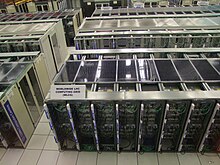Worldwide LHC Computing Grid
This article mayrequirecleanupto meet Wikipedia'squality standards.The specific problem is:Talk:Worldwide LHC Computing Grid#Inconsistences.(March 2014) |
TheWorldwide LHC Computing Grid(WLCG), formerly (until 2006)[1]theLHC Computing Grid(LCG), is an international collaborative project that consists of a grid-basedcomputer networkinfrastructure incorporating over 170 computing centers in 42 countries, as of 2017[update].It was designed byCERNto handle the prodigious volume of data produced byLarge Hadron Collider(LHC) experiments.[2][3]

By 2012, data from over 300 trillion (3×1014) LHC proton-proton collisions had been analyzed,[4]and LHC collision data was being produced at approximately 25petabytesper year. As of 2017[update]the LHC Computing Grid is the world's largestcomputing gridcomprising over 170 computing facilities in aworldwide networkacross 42 countries[4][5][6]scattered around the world that produce a massive distributed computing infrastructure with about 1,000,000 CPU cores, providing more than 10,000 physicists around the world with near real-time access to theLHCdata, and the power to process it.
Background[edit]
The Large Hadron Collider at CERN was designed to test the existence of theHiggs boson,an important but elusive piece of knowledge that had been sought byparticle physicistsforover 40 years.A very powerfulparticle acceleratorwas needed, because Higgs bosons might not be seen in lower energy experiments, and because vast numbers of collisions would need to be studied. Such a collider would also produce unprecedented quantities of collisiondatarequiring analysis. Therefore, advanced computing facilities were needed to process the data.
Description[edit]
A design report was published in 2005.[7] It was announced to be ready for data on 3 October 2008.[8] A popular 2008 press article predicted "the internet could soon be made obsolete" by its technology.[9] CERN had to publish its own articles trying to clear up the confusion.[10] It incorporates both privatefiber-optic cablelinks and existing high-speed portions of the publicInternet.At the end of 2010, the Grid consisted of some 200,000 processing cores and 150petabytesof disk space, distributed across 34 countries.[11]
The data stream from the detectors provides approximately 300GByte/s of data, which after filtering for "interesting events", results in a data stream of about 300MByte/s. The CERN computer center, considered "Tier 0" of the LHC Computing Grid, has a dedicated 10Gbit/s connection to the counting room.
The project was expected to generate multipleTBof raw data and event summary data, which represents the output of calculations done by theCPUfarm at the CERN data center. This data is sent out from CERN to thirteen Tier 1 academic institutions in Europe, Asia, and North America,[12]via dedicated links with 10 Gbit/s or higher of bandwidth. This is called the LHC Optical Private Network.[13] More than 150 Tier 2 institutions are connected to the Tier 1 institutions by general-purposenational research and education networks.[14] The data produced by the LHC on all of its distributed computing grid is expected to add up to 200PBof data each year.[15]In total, the four main detectors at the LHC produced 13 petabytes of data in 2010.[11]
The Tier 1 institutions receive specific subsets of the raw data, for which they serve as a backup repository for CERN. They also perform reprocessing when recalibration is necessary.[14]The primary configuration for the computers used in the grid is based onCentOS.[16]In 2015, CERN switched away fromScientific Linuxto CentOS.[16]
Distributed computingresources for analysis by end-user physicists are provided by multiple federations across the Europe, Asia Pacific and the Americas.
See also[edit]
References[edit]
- ^Hayes, Jacqui (21 December 2011)."Happy 10th Birthday, WLCG!".International Grid Science This Week.Retrieved2012-12-20.
- ^ Worldwide LHC Computing Grid,CERN,January 2017,retrieved2017-08-04
- ^ About,CERN,January 2017,retrieved2017-08-04
- ^abHunt for Higgs boson hits key decision point
- ^Worldwide LHC Computing Grid about page2017:"Even after filtering out 99% of it, in 2017 we're expecting to gather around 50 petabytes of data. That's 50 million gigabytes, the equivalent to nearly 15 million high-definition (HD) movies."
- ^Worldwide LHC Computing Grid main page2017:"WLCG is the world's largest computing grid. It is supported by many associated national and international grids across the world, such as European Grid Initiative (Europe-based) and Open Science Grid (US-based), as well as many other regional grids."
- ^LHC Computing Grid: Technical Design Report(PDF).The LCG TDR Editorial Board. 20 June 2005.ISBN978-92-9083-253-9.Retrieved2 October2011.
{{cite book}}:|work=ignored (help) - ^"LHC GridFest".CERN. 2008.
- ^Jonathan Leake (6 April 2008)."Coming soon: superfast internet".The Times.London. Archived fromthe originalon August 5, 2011.Retrieved25 January2013.
- ^"The Grid: separating fact from fiction".CERN. May 2008.Retrieved25 January2013.Adapted from an article originally published in Symmetry Breaking.
- ^abGeoff Brumfiel (19 January 2011)."High-energy physics: Down the petabyte highway".Nature.469(7330): 282–283.Bibcode:2011Natur.469..282B.doi:10.1038/469282a.PMID21248814.
- ^"The Grid: A system of tiers".CERN.Retrieved2 October2017.
- ^"Network transfer architecture".CERN.Retrieved2 October2011.
- ^abfinal-draft-4-keyArchivedMay 26, 2008, at theWayback Machine
- ^Brodkin, Jon (28 April 2008)."Parallel Internet: Inside the Worldwide LHC computing grid".Techworld.com.
- ^abCERN."Linux @ CERN: /linux/nextversion.shtml".linux.web.cern.ch.Retrieved2016-02-07.
